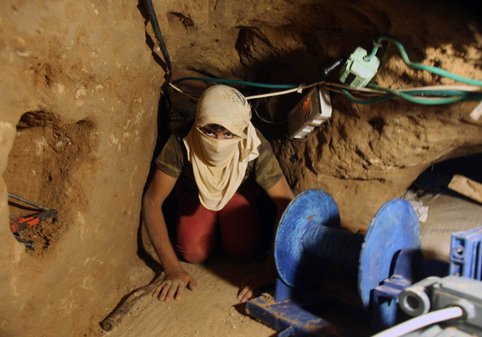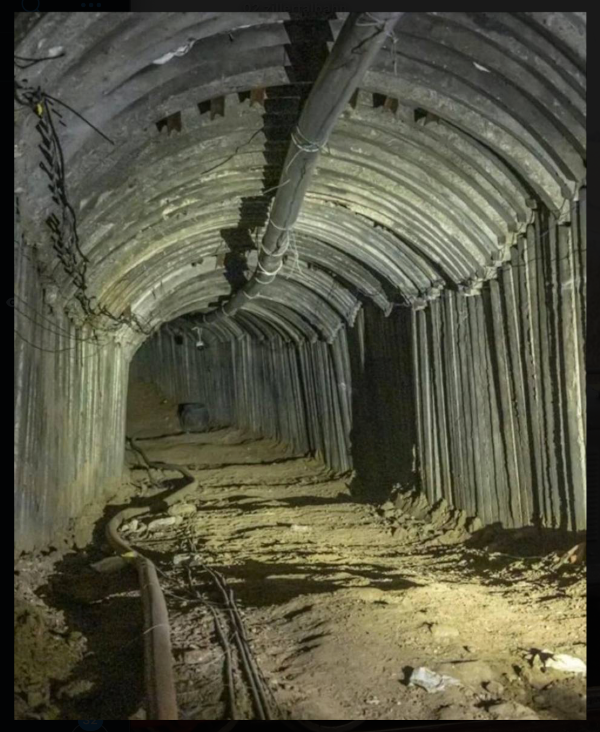"All I hear is whispering, terror is all around me; they plot together against me, scheming to take my life." Psalm 31:13
Gaza's Terror Tunnels
This page was created and updated in 2016 and while the principles remain, larhe developments have occurred.
1 Hamas Tunnel needs 350 truckloads of building materials - at a cost of 3 million US Dollars
(entering through Israel's alleged blockade)
So far the IDF has found 31 tunnels (total cost 93 million US Dollars)
With these materials the Hamas government could have built
86 homes - 7 mosques - 6 schools - 19 medical clinics
Who knows how many civilian bomb shelters?
Plus the cost in terms of at least 160 children died digging tunnels for Hamas'

Use of child labor is not stopped by police in Gaza, where children's "nimble bodies" help dig the tunnels that lead into Israel and Egypt, according to a 2012 paper written for the Journal of Palestine Studies.
The paper, titled Gaza's Tunnel Phenomenon: The Unintended Dynamics of Israel's Siege says that little had been done to stop the phenomenon of child labor during the digging of the tunnels by Hamas in Gaza. In December 2011, the paper's author Nicolas Pelham accompanied a police patrol in Gaza and reported that "nothing was done to impede the use of children in the tunnels, where, much as in Victorian coal mines, they are prized for their nimble bodies."
He continued and said "at least 160 children have been killed in the tunnels, according to Hamas officials." (at the time of writing the report, presumably)
In the first 21 days of Operation Protective Edge, IDF forces uncovered 31 tunnels leading into Israel.
IDF Soldiers Find Mosque with Weapons and Tunnel Openings
The tunnels are more than just a convenience for smuggling and hiding arms; they are a weapon of terror against Israel.

Update - in 2016 - after the completion of the super wall.
The NIS 3.5 billion ($1.1 billion) project has taken over three years to complete and is meant to end the threat of cross-border attack tunnels from the Palestinian enclave, which the Strip's Hamas rulers have utilized to deadly effect. The barrier is made up of several components: an underground reinforced concrete wall that is studded with sensors to detect tunnels; a 20-foot (six-meter) steel fence; a network of radar arrays and other surveillance sensors; and remote-controlled weaponry.
"This barrier, a creative, technological project of the first order, denies Hamas one of the capabilities that it tried to develop and puts a wall of iron, sensors and concrete between it and the residents of the south," Defense Minister Benny Gantz said at the ceremony on Tuesday afternoon
Update - in 2024 - after the Hamas invasion of October 7th 2023
Early on Shabbat morning of October 7th (Shmini Atzeret, a holy day) Hamas fighters and Gazan "civilians" crashed the above ground fences and went on a rampage of murder, rape, mutilation and abduction. It appeared to many that the military had been too complacent, perhaps because of the high-tech boundary
As the IDF progressed their ground incursion into Gaza, an incredible number of tunnels were discovered - serving various military purposes.
Many, tunnel entrances were found under "civilian" housing, providing an underground travel network for the movement of fighters, weapons, etc that was safe from aerial surveilance.
Tunnel network hubs, living accomodation and command centres were found under all the hospitals and many UN/UNRWA buildings. Hostages were likely held there but moved on as the IDF closed in.
In late May 2024, as the IDF closed in on Rafah (the last Hamas stronghold) they started finding the bodies of hostages. It is not yet known how many, if any, of the hostages are still alive underground or moved on further.

After Egypt, along with Quatar and the USA had been trying to force a cease fire (to save Hamas from defeat) The IDF operations in Rafah - on the Egyptian border - they discovered truck size tunnels under the border, while Egypt had been strengthening their above ground to exclude Palestinian refugees. Clearly Egypt, Quatar and USA (bad faith negotiators) were trying to prevent Israel discovering Egypt's underground support of Hamas.
As of 25/05/24, Hamas head of terrorism, Yahya Sinwar, has not been found - dead or alive - but the discovery of the Egypt tunnels shows that He and any surviving hostages could now be in Egypt.
Hamas Attack Tunnels
Hamas's Attack Tunnels: Analysis and Initial Implications
Lt. Col. (ret.) Jonathan Dahoah Halevi - July 23, 2014
Ismail Haniyeh, the Hamas prime minister, delivered a revealing speech on March 23, 2014, in which he stressed the strategic importance of the Hamas attack tunnels, which, he argued, have changed the balance of power with Israel, when taken together with his organization's military build-up.
In the meantime, the IDF's war against the tunnels continues. IDF forces thwarted another terror attack after two groups of Hamas operatives (numbering about ten) infiltrated from Gaza to Israel through a tunnel, apparently on their way to carry out a mass casualty attack at Kibbutz Erez and/or Kibbutz Nir Am.
Since Operation Protective Edge began, IDF forces have foiled several other attempted attacks by Hamas near Kibbutz Sufa and Kibbutz Nirim that also made use of attack tunnels, while uncovering and blowing up dozens of tunnels in Gaza along its border with Israel.
These tunnels penetrate deep into Israeli territory, sometimes reaching a length of 2.4 kilometers (1.5 miles).Hamas has accumulated a great deal of experience in using the tunnels for operational purposes. Since 2000, hundreds of tunnels have been dug along Gaza's border with Egypt, providing a lifeline for Hamas's military buildup. The tunnels have been a main conduit for Palestinian imports from Egypt on a scale of millions of dollars annually, and for smuggling military supplies (from ammunition to missiles) and the construction materials needed to build the network of attack tunnels in Gaza. Importation through the tunnels (it was in Egypt's political interest that this be referred to as "smuggling”) was fully controlled by the Hamas government, which levied a tax on the items and used its huge profits to accelerate its military buildup and preparation for hostilities with Israel.
During the Second Intifada, which began in September 2000, Hamas made use of attack tunnels that were dug opposite IDF positions along the Philadelphi Route. These tunnels enabled Hamas to lay powerful explosive charges beside the IDF positions in an effort to destroy them.
On June 25, 2006, a joint Hamas/Jaish al-Islam (an al-Qaeda affiliate) unit infiltrated from Gaza to Israel through a tunnel whose opening was about a hundred meters from the border in Israeli territory, near the Kerem Shalom crossing. In that attack, an officer and a soldier were killed and the soldier Gilad Shalit was abducted.
Islamic Jihad fighters were digging new tunnels in Gaza as soon as the "cease fire" began - and showing them to Al Jazeera reporters
Hamas, Hizbullah and even North Korean Tunnels
Based on Hizbullah's experience in the Second Lebanon War, and with the assistance and guidance of Iran, Hamas has also made use of the tunnels to build an underground network of missile launchers. During the Second Lebanon War, Hizbullah greatly expanded its underground fortifications in Southern Lebanon with the aid of the Islamic Revolutionary Guard Corps (IRCG) and even North Korean engineers, who also provided guidance in how to incorporate the tunnels into Hizbullah's military doctrine.
Tunnel warfare provided armies facing a technologically superior adversary with an effective means for countering its air superiority. For example, a tunnel is opened only briefly to launch rockets and then immediately closed to prevent detection of the launchers' location by the IDF. The concealment of these launchers in tunnels, in the heart of the civilian population, makes it very difficult to detect them in real time and attack them.
The rule of the Muslim Brotherhood in Egypt during 2012-2013 was a golden age for Hamas, the Palestinian branch of the Brotherhood. During the tenure of President Mohamed Morsi and his foreign policy adviser Khaled al-Kazaz (a resident of Canada), missiles and a great deal of ammunition moved through the tunnels to Gaza, along with the materials needed to construct plants and manufacture missiles. In addition to receiving close to half the budget of the Palestinian Authority, the economic aid the Hamas government received from international actors, including European countries, Qatar, and the United Arab Emirates, has helped it channel significant resources to its military buildup and the construction of the attack tunnels.
Also of help to Hamas were Israeli and international human rights organizations, which constantly pressured Israel to allow the entry of cement and iron into Gaza for purposes of civilian construction. In reality, these materials mainly went into building the attack-tunnel network, instead of houses for the Palestinians.
The attack tunnels create a new equation in the power balance between Israel and Hamas. They give Hamas an ability to infiltrate Israel and carry out strategic attacks involving mass killing, along with an ability to launch missiles from locations concealed within civilian population centers that serve, in effect, as human shields. Should Hamas retain in the future 20 tunnels, and dispatch 50 operatives in each, they could deploy 1,000 men behind Israeli lines. The tunnels would allow Hamas to wreak havoc if they are left in place. Hizbullah's tactics, learned from Iran, have been replicated in Gaza, particularly the use of the tunnels to provide "breathing space” in waging the military campaign. The Hamas-Hizbullah-Iranian aim is to cause as much harm as possible to the civilian population and weaken Israel by damaging its economy.
Like Hizbullah, Hamas in the current round has tried to strike strategic targets in Israel and inflict mass casualties, including the nuclear reactor in Dimona, the chemical plants in Haifa, and Ben-Gurion International Airport. Despite the reconciliation agreement with Fatah and the establishment of the unity government, one of Hamas's objectives in the war is to ignite another intifada on the West Bank aimed ultimately at the toppling of Palestinian Authority rule and instituting a Hamas takeover of the Palestinian national movement. This current round of fighting highlights the importance of continued Israeli security control of key areas of the West Bank to prevent a Hamas takeover of the Palestinian Authority, and the maintenance of minimal defensible borders should a Palestinian state be established.
Lt. Col. (ret.) Jonathan D. Halevi is a senior researcher of the Middle East and radical Islam at the Jerusalem Center for Public Affairs. He is a co-founder of the Orient Research Group Ltd.
Updated 25/05/24
Click the banner below to go to the site map and choose another page

